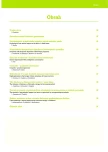The influence of tibolonee on fibrocystic changes in the mammary gland
Authors:
L. Večeřová; J. Vachoušek; V. Smejkal
Authors‘ workplace:
Centrum pro nemoci prsu, Praha
Published in:
Prakt Gyn 2007; 11(2): 82-86
Overview
Objective:
Assessment of changes in the ultrasonographic image of the mammary gland in postmenopausal women with fibro-cystic transformation taking tibolone instead of hormone substitution therapy; a prospective non-randomised study.
Material and method:
Fifty postmenopausal women with mammographically and ultrasonographically proven fibrocystic transformation of the mammary gland were included in the prospective, non-randomised study. The women were divided into 2 groups based on acute climacteric syndrome and the resulting wish to take hormonal substitution therapy. The 1st group included women (n = 30) who wished to take tibolone (Livial® Organon) or to continue taking the drug after a 1 to 12 month experience. The 2nd group included women (n = 20) who did not wish and did not take hormonal therapy. Changes in the ultrasound image were monitored in both the groups at 3, 6 and 12 month intervals from the start of study. The results were statistically evaluated using the pair t-test.
Results:
Significant decrease (p < 0.0001) in the diameter of simplex cysts from 12.42 ± 1.4 mm to 8.3 ± 2.18 mm was recorded during one year follow up in women taking tibolone. The size of simplex cysts remained unchanged in the control group of women without therapy.
Conclusion:
The study has shown statistically significant reduction in the diameter of simplex cysts in the area of fibrocystic transformation of the mammary gland in women taking tibolone versus the group of women without treatment. The above results correspond to data in literature on the subject and provide further evidence for the theory of selective regulation of tissue estrogenic activity by tibolone.
Key words:
tibolone – hormone substitution therapy – ultrasonographic breast examination – fibrocystic breast transformation
Sources
1. Anderson TJ, Ferguson DJ, Raab GM. Cell turnover „resting“ human brest: Influence of parity, contraceptive pill, age and laterality. Br J Cancer 1982; 46: 376-382.
2. Boiocchi M. The genetic nature of cancer. Eur J Cancer Prev 1996; 5(5): 370-372.
3. Cancer Committae College of American Pathologists. Consensus Meeting: Is „fibrocystic disease“ of the breast precancerous? Arch Path Lab Med 1986; 110: 171-175.
4. Daneš J. Základy mamografie. Praha: X-Egem 2002.
5. Hughes LE. A unifying koncept for benign breast disordes of the brest: ADNI. In: Donegan WL, Spratt JS (eds). Cancer of breast. 4. ed. Philadephia: W. B. Sauders Company 1995: 78-86.
6. Lundstrom E, Christow A, Kersemaekers W et al. Effects of tibolone and continuous combined hormone replacement therapy on mammographic breast density. Am J Obstet Gynecol 2002; 186: 717-721.
7. Özdemir A, Konus Ö, Nas T et al. Mammographic and ultrasonografic study of changes in the breast related to HRT. Int J Obstet Gynecol 1999; 67: 23-32.
8. Sarti DA, Bein ME, Brenner RJ, Vnstein AL. Spontaneous regression of interval benign cyst of the breast. Radiology 1994; 2: 365-368.
9. Skovajsová M. Mamodiagnostika Integrovaný přístup. Praha: Galén 2003.
10. Strnad P, Daneš J. Nemoci prsu pro gynekology. Praha: Grada 2001.
11. Tabár L. The Tabar classification of mammographic parenchymal patterns. Eur J Radiol 1997; 24: 131-136.
12. Yenen MC, Dede M. Hormone replacement therapy in postmenopausal women with benign fibrocystic mastopathy. Climacteric 2003; 6: 146-150.
Labels
Paediatric gynaecology Gynaecology and obstetrics Reproduction medicineArticle was published in
Practical Gynecology

2007 Issue 2
Most read in this issue
- Cerazette – practical experience
- Psychological and medical aspects of the birth of a dead foetus
- The influence of tibolonee on fibrocystic changes in the mammary gland
- Bisphosphonates in the therapy of bone metastases of breast carcinoma
